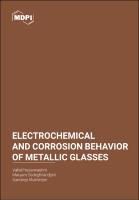Electrochemical and Corrosion Behavior of Metallic Glasses
Author(s)
HASANNAEIMI, VAHID
Sadeghilaridjani, Maryam
Mukherjee, Sundeep
Language
EnglishAbstract
Metallic glasses are multi-component metallic alloys with disordered atomic distribution
unlike their crystalline counterparts with long range periodicity in arrangement of atoms.
Metallic glasses of different compositions are being commercially used in bulk form and
as coatings because of their excellent corrosion resistance. This book was written with
the objective of providing a comprehensive understanding of the electrochemical and
corrosion behavior of metallic glasses for a wide range of compositions. Corrosion in
structural materials leads to rapid deterioration in the performance of critical components
and serious economic implications including property damage and loss in human life.
Discovery and development of metallic alloys with enhanced corrosion resistance will
have a sizable impact in a number of areas including manufacturing, aerospace, oil and
gas, nuclear industry, and load-bearing bioimplants. The corrosion resistance of many
metallic glass systems is superior compared to conventionally used alloys in different environments. In this book, we discuss in detail the role of chemistry, processing conditions,
environment, and surface state on the corrosion behavior of metallic glasses and compare
their performance with conventional alloys. Several of these alloy systems consist of all
biocompatible and non-allergenic elements making them attractive for bioimplants, stents,
and surgical tools. To that end, critical insights are provided on the bio-corrosion response
of some metallic glasses in simulated physiological environment.
Keywords
Corrosion; Metallic Glass; Electrochemistry; Amorphous Alloy; Glass Forming AbilityDOI
10.3390/8 books978-3-03943-723-8ISBN
9783039437245, 9783039437238Publication date and place
Basel, 2021Classification
Environmental science, engineering and technology
Industrial chemistry and manufacturing technologies
Pages
104Metrics
Measures
Timeline
Geographical
Information


 Download
Download Web Shop
Web Shop